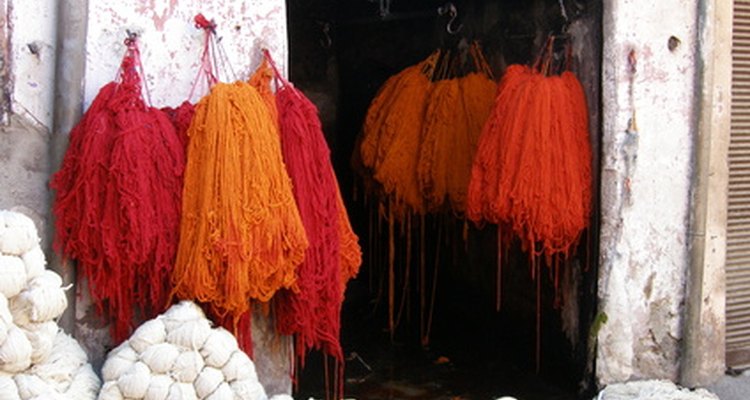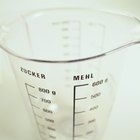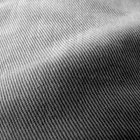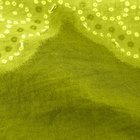
Many people toss any clothing item they want to dye into the washing machine with a box of acid-based powder color, giving no thought to the fabric. But synthetic fibers, such as polyester, don't take these dyes well and can be destroyed in the process. Plus, there is no way to dye any colored fabric white without first removing the color. Luckily, there are products made specifically for synthetic fibers both to remove the original dye—dark blue in this example—from your fabric and to dye the raw fabric pristine white.
Combine the dye-stripping product and the amount of water required by your particular product (as designated on the packaging) in a stainless steel pot. Bring this mixture to a boil over medium heat. Remove the pot from the heat and place your fabric into the steaming, diluted dye stripper. Let the fabric soak, completely submersed, for 30 minutes.
Remove the fabric from the pot using a pair of tongs. Place the fabric in your sink and rinse it thoroughly until the water runs clear. Examine the fabric to ensure that all the color has been removed. Return the fabric to the stripper solution, if necessary, for 15 minutes at a time to remove any remaining dye. Rinse completely after each submersion.
Pour the remaining liquid from your pot into an empty gallon jug for disposal. Do not rinse it down the sink—the chemical mixture may damage older pipes. Clean your pot thoroughly with warm water and dish detergent.
Wash your fabric in the washing machine, without detergent, on its hottest setting.
In one large pot, bring 1 cup of water to a boil. Remove it from the burner, then add the amount of white disperse dye powder directed by your particular product. Let this mixture cool completely, then stir it well with a metal spoon.
Lay the two nylon stockings squares over the top of a large bowl. Pour the mixture from the pot into the large bowl, through the nylon. Remove the nylon carefully, catching any lumps of powder, then dispose of them.
Boil a cup of water in the second stainless steel pot. Again, remove the pot from the burner and add the directed amount of your chemical dye carrier. Let this cool completely, stir well with your rinsed metal spoon, then pour this mixture into a second large bowl.
Clean your first pot well with warm water and dish soap. Pour in 2-1/2 gallons of water and place it over medium heat. Bring this water to 120 degrees Fahrenheit (49 degrees Celsius) on a candy thermometer. Remove the pot from the heat. Add 1/2 teaspoon of fabric-dying detergent, 11 teaspoons of white distilled vinegar, the diluted chemical dye carrier, and the strained dye mixture. Stir after each ingredient is added using your cleaned metal spoon. Add your fabric to the pot.
Fill your second pot with water and bring it to 180 degrees Fahrenheit (82 degrees Celsius) on a candy thermometer. Place the first pot onto the burner again and bring to a boil quickly over high heat, stirring the fabric around continuously to prevent a fire hazard. Let the fabric soak in the boiling mixture for a half hour. Use tongs to remove the fabric from this pot and immediately submerge it in the second pot of plain, hot water. Let the fabric sit in the clean water for 10 minutes.
Rinse your tongs and use them to remove the fabric from the pot. Pour the contents of the two pots down the sink drain and wash your pots well by hand or in the dishwasher. Wash the fabric in your washing machine on its hottest setting with some of the leftover fabric-dying detergent. Tumble dry the fabric or lay it out to air dry.
Related Articles

How to Dye Polyester Fabric

How to Dye Nomex

How to Dye Tulle

How to Dye Fabric Black

How to Die Fabric White

How to Whiten White Polyester Pants

How to Bleach Satin

How to Dye Pantyhose

How to Wash Dupioni Silk

How to Bleach Khakis White

How to Soak Tie-Dye in Baking Soda

Instructions for Dylon Permanent Fabric ...

How to Dye Faded Black Dress Pants

How to Bring White Back From Yellowing ...

How to Get Color Out of Nylon Fabric

How to Dye a Silk Dress

How to Dye a White Bra Tan

How to Dye Tulle

How to Dye Bathrobes

How to Dye Leotards
References
Writer Bio
Jourdan Townsend has been writing since childhood. Her articles appear in a collection of student works at the University of Oklahoma as well as in the school's "Honors College Journal." Townsend also composes poetry, some of which can be found in an edition of the "Anthology of Poetry by Young Americans." Townsend holds a Bachelor of Arts in communication.
Photo Credits
Dye image by vertellis from Fotolia.com